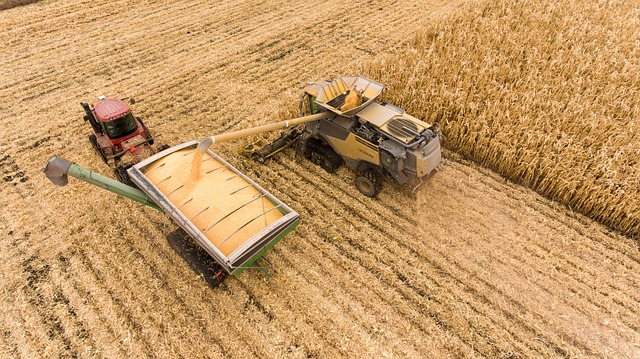Maintaining a lawn tractor battery is crucial for ensuring both the efficiency and safety of your lawn tractor. There are two main types of batteries used in these machines: lead-acid and absorbed glass mat (AGM) batteries. Lead-acid batteries are known for their affordability and durability but require regular maintenance, including monitoring water levels due to the presence of sulfuric acid. AGM batteries are a low-maintenance alternative with a longer lifespan and better recovery from deep discharges. It's essential to understand your lawn tractor's battery system components and adhere to safety measures when installing or repairing the battery, using insulated tools and personal protective equipment. Proper installation involves careful preparation, cleaning terminals for the new battery, inspecting and replacing damaged terminals, and ensuring the new battery is the correct type and size. Common starting issues with a lawn tractor are often due to dirty or corroded battery terminals, which can be cleaned with baking soda and water. If testing reveals the battery still holds no charge, it may need replacement. Regular maintenance includes cleaning terminals, securing connections with the correct torque, and ensuring the battery remains fully charged. Consistent upkeep of your lawn tractor battery will not only prolong its life but also ensure it operates reliably for all your yard maintenance tasks. Always consult the owner's manual for model-specific guidance on battery care.
When maintaining a well-tended lawn, the role of your lawn tractor’s battery cannot be overstated. Ensuring secure and efficient connections is paramount for both safety and functionality. This article delves into the essential aspects of understanding different lawn tractor batteries and their components to facilitate safe connections. Follow our step-by-step guide for a flawless battery hookup, and stay ahead of common connection pitfalls with our troubleshooting tips. Additionally, we’ll outline key maintenance practices to prolong your lawn tractor battery’s lifespan, keeping your garden tools in optimal working order.
- Understanding Lawn Tractor Battery Types and Components for Safe Connection
- Step-by-Step Guide to Securely Connecting Your Lawn Tractor Battery
- Troubleshooting Common Issues with Lawn Tractor Battery Connections
- Maintenance Best Practices to Extend the Life of Your Lawn Tractor Battery Connection
Understanding Lawn Tractor Battery Types and Components for Safe Connection

When it comes to maintaining a well-functioning lawn tractor, understanding your lawn tractor battery and its components is paramount for safe and efficient operation. There are primarily two types of batteries used in lawn tractors: lead-acid and absorbed glass mat (AGM) batteries. Lead-acid batteries have been the standard for many years due to their affordability and reliability, but they require more maintenance, such as checking the water levels and handling with caution because they contain sulfuric acid. On the other hand, AGM batteries are sealed and maintenance-free, offering longer life spans and superior performance in terms of deep discharge recovery.
For safe connections, it’s crucial to familiarize yourself with the battery’s components, including the terminals (positive and negative), cables, and the battery itself. The positive terminal is typically marked with a red cover or indicator and is connected to the engine’s charging system, while the negative terminal, often with a black cover, connects to the lawn tractor’s frame. When connecting or disconnecting the battery, ensure that the engine is turned off and the parking brake is engaged. Use a clean, insulated wrench to loosen the terminals’ nuts before removing the cables, and when reattaching them, tighten the nuts securely without overtightening, which can damage the terminals. Always wear safety gloves and eyewear to protect yourself from electrical shocks or acid leaks. Understanding these aspects of your lawn tractor battery will not only extend its lifespan but also ensure a safer working environment for you. Remember to always consult the owner’s manual for specific instructions related to your lawn tractor model, as different models may have variations in their battery setups and connections.
Step-by-Step Guide to Securely Connecting Your Lawn Tractor Battery

When connecting a battery to your lawn tractor, safety and proper installation are paramount to ensure optimal performance and longevity of both the battery and the tractor itself. Begin by gathering all necessary tools and materials, including a new battery, wrenches, pliers, gloves, safety glasses, and an understanding of your lawn tractor’s electrical system. Carefully remove the old battery from the tractor, taking note of how it was positioned and connected.
To install the new lawn tractor battery, first, clean the terminals on the tractor where the battery will connect. Use a wire brush to remove any corrosion or debris that may interfere with a solid electrical connection. Next, inspect the terminals for damage or wear; if they appear compromised, replace them before proceeding. Ensure that the battery is the correct type and size for your lawn tractor. Position the new battery in place of the old one, ensuring it’s securely mounted to prevent movement during operation. Connect the positive (red) terminal first, aligning it with the corresponding positive post on the tractor. Tighten the nut securely using a wrench, but be careful not to over-tighten and strip the post or damage the terminal. Repeat this process for the negative (black) terminal, ensuring a snug fit without applying excessive force. Once both terminals are securely attached, visually inspect all connections for any signs of looseness or potential shorts. If everything looks and feels correct, replace the battery cover or housing to protect the connections and the battery itself from environmental factors. Always remember to wear appropriate personal protective equipment when working with batteries, as they can be hazardous if mishandled. Properly connecting your lawn tractor battery according to these steps will ensure a safe and reliable operation of your tractor.
Troubleshooting Common Issues with Lawn Tractor Battery Connections

When encountering issues with a lawn tractor battery, it’s often the connections that are at fault rather than the battery itself. Dirt, corrosion, and loose or incorrectly tightened terminals can all disrupt the electrical flow necessary for your tractor to start. To troubleshoot these common problems, begin by inspecting the battery terminals and cables for any signs of wear or damage. If you find a buildup of white or brown powdery deposits at the terminal posts, this is likely corrosion, caused by a reaction between the electrolyte and the metal parts. This can be removed with a mixture of baking soda and water using a soft-bristled brush. Ensure that the connections are clean and free of debris, as even a thin layer of grime can prevent a proper electrical connection.
After cleaning, check that the terminals are securely fastened. Overly tight or loose connections can both cause performance issues. Use a torque wrench to tighten the cable clamps to the manufacturer’s specified torque setting to avoid damaging the terminal or the cable. If the battery still doesn’t hold a charge, consider testing the battery with a multimeter to measure its voltage and capacity. A weak charge could indicate that it’s time to replace the battery. Inspect the cables for any nicks, cuts, or frays, as these can compromise the integrity of the electrical circuit. Lastly, ensure that the battery is properly charged; some batteries may require a longer charging period than others, and not all chargers are created equal. By addressing these common issues with lawn tractor battery connections, you can often resolve starting problems without needing to purchase a new battery.
Maintenance Best Practices to Extend the Life of Your Lawn Tractor Battery Connection

When it comes to maintaining the longevity of your lawn tractor battery, regular upkeep is paramount. To ensure optimal performance and prolong the life of your battery connections, it’s essential to perform routine inspections. Begin by cleaning the terminals regularly with a wire brush to remove any corrosion or grime that can form over time. This not only prevents electrical connection issues but also ensures the battery operates efficiently. Use a solution of baking soda and water to gently scrub away any stubborn residues, then thoroughly rinse and dry the area.
In addition to cleaning, securing the connections with the correct amount of torque is crucial. Over-tightening can cause damage to the terminals, while under-tightening may lead to poor battery contact. Consult your lawn tractor’s user manual for the recommended torque settings when tightening the terminals. Additionally, inspect the battery’s hold-down clamp and ensure it’s fastened securely to prevent any movement that could strain the connections or the battery itself. Regularly check the fluid levels in a liquid electrolyte battery; if necessary, add distilled water to maintain the correct electrolyte concentration. By diligently adhering to these maintenance best practices, you can significantly extend the life of your lawn tractor battery and its connections, ensuring reliable operation for all your lawn care tasks.
When maintaining your lawn tractor’s battery, adhering to safe and effective practices is paramount for both operational longevity and personal safety. This article has outlined the essential types of lawn tractor batteries and their components, providing a clear understanding necessary for secure connections. The step-by-step guide presented ensures that even novice users can confidently connect their battery without risking damage or injury. Additionally, addressing common issues with lawn tractor battery connections equips you with the troubleshooting skills to resolve minor electrical hiccups efficiently. Regular maintenance as detailed in the best practices section is crucial for extending the life of your lawn tractor’s battery connection. By following these guidelines, you can ensure your lawn tractor remains reliable and ready for all your outdoor needs.
